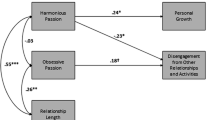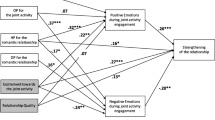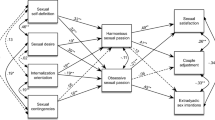Abstract
Based on the Dualistic Model of Passion (Vallerand et al. in J Pers Soc Psychol 85:756–767, 2003), a bidimensional perspective on romantic passion, that distinguishes between harmonious and obsessive passions, is proposed. The present research aimed at examining how these two types of romantic passion relate to indices of relationship quality, how one’s own passions are associated with one’s partner’s passions and relationship quality, and how the two types of passion relate to relationship stability over time. Study 1 revealed that harmonious passion was more strongly associated with high relationship quality than obsessive passion. Using a dyadic design, Study 2 revealed that the findings of Study 1 applied to both genders. In addition, one’s own passion predicted partner’s relationship quality, partners were not always matched in terms of the predominant type of passion, and passion matching did not predict relationship quality. Finally, Study 3 revealed that types of passion predicted relationship status over a 3-month period.
Similar content being viewed by others
Notes
The passion subscale of the PRQCI (Fletcher et al. 2000) is composed of items reflecting sexuality (e.g., “Our relationship is sexually passionate”). For this reason, we refer to it as a measure of sexual passion.
Because of the interdependent nature of couple data, we used a dyad structure (Kenny et al. 2006) where women’s and men’s data are entered under a same dyadic unit to control for shared variance. Each case or line of data therefore represents a couple in which partners are nested.
Mean levels of harmonious passion were 5.47 and 5.54 and mean levels of obsessive passion were 3.97 and 3.74 for men and women, respectively.
Analyses revealed no significant differences between this subset and the rest of the sample on harmonious passion, obsessive passion, relationship quality, age, and gender of participants at Time 1. However, participants who took part in the follow-up study had a shorter relationship length (M = 51.58 months) at Time 1, F(1, 320) = 4.63, p < .05, than participants who did not complete the follow-up (M = 70.91 months), although the magnitude of this difference was small (R 2 = .01).
In a pilot study, the 12-item and 14-item version of the RPS were shown to be highly correlated (r = .87 for the harmonious passion subscale; r = .84 for the obsessive passion subscale) and were shown to lead to similar results in terms of their associations with various outcomes (e.g., relationship quality, rumination, internalization of partner in the self, etc.).
Of the 143 participants, 7.7 % (n = 11) of them were no longer involved in the same romantic relationship at Time 2. These participants did not have a different relationship length at Time 1 than those who were still involved in the same relationship at Time 2 (F [1, 142] = 2.13, p = .15, R 2 = .01).
References
Acker, M., & Davis, M. H. (1992). Intimacy, passion, and commitment in adult romantic relationships: A test of the triangular theory of love. Journal of Social and Personal Relationships, 9, 21–50.
Aron, A., & Aron, E. N. (1991). Love and sexuality. In K. McKinney & S. Sprecher (Eds.), Sexuality in close relationships (pp. 25–48). Hillsdale, NJ: Erlbaum.
Aron, A., & Henkemeyer, L. (1995). Marital satisfaction and passionate love. Journal of Social and Personal Relationships, 12, 139–146.
Aron, A., & Westbay, L. (1996). Dimensions of the prototype of love. Journal of Personality and Social Psychology, 70, 535–551.
Baillargeon, J., Dubois, G., & Martineau, R. (1986). Traduction française de l’Échelle d’ajustement dyadique. [French translation of the Dyadic Adjustment Scale]. Canadian Journal of Behavioral Sciences, 18, 25–34.
Baumeister, R. F., Wotman, S. R., & Stillwell, A. M. (1993). Unrequited love: On heartbreak, anger, guilt, scriptlessness, and humiliation. Journal of Personality and Social Psychology, 64, 377–394.
Davis, K. E., & Latty-Mann, H. (1987). Love styles and relationship quality: A contribution to validation. Journal of Social and Personal Relationships, 4, 409–428.
Deci, E. L., & Ryan, R. M. (2002). Handbook of self-determination research. Rochester, NY: The University of Rochester Press.
Fehr, B., & Broughton, R. (2001). Gender and personality differences in conceptions of love: An interpersonal theory analysis. Personal Relationships, 8, 115–136.
Fletcher, G. J. O., Simpson, J. A., & Thomas, G. (2000). The measurement of perceived relationship quality components: A confirmatory factor analytic approach. Personality and Social Psychology Bulletin, 26, 340–354.
Gao, G. (2001). Intimacy, passion, and commitment in Chinese and US American romantic relationships. International Journal of Intercultural Relations, 25, 329–342.
Hahn, J., & Blass, T. (1997). Dating partner preferences: A function of similarity of love styles. Journal of Social Behavior and Personality, 12, 595–610.
Hatfield, E., Pillemer, J. T., O’Brien, M. U., & Le, Y. L. (2008). The endurance of love: Passionate and companionate love in newlywed and long-term marriages. Interpersona, 2, 35–64.
Hatfield, E., & Rapson, R. L. (1993a). Historical and cross-cultural perspectives on passionate love and sexual desire. Annual Review of Sex Research, 4, 67–97.
Hatfield, E., & Rapson, R. L. (1993b). Love and attachment processes. In M. Lewis & J. M. Haviland (Eds.), Handbook of emotion (2nd ed., pp. 654–662). New York: Guilford Press.
Hatfield, E., & Rapson, R. L. (1993c). Love, sex, and intimacy: Their psychology, biology, and history. New York: Harper Collins College Publishers.
Hatfield, E., & Rapson, R. L. (2000). Love and attachment processes. In M. Lewis & J. M. Haviland-Jones (Eds.), Handbook of emotions (pp. 595–604). New York: Guilford Press.
Hatfield, E., & Sprecher, S. (1986). Measuring passionate love in intimate relationships. Journal of Adolescence, 9, 383–410.
Hatfield, E., & Walster, G. W. (1978). A new look at love. Lantham, MA: University Press of America.
Hendrick, C., & Hendrick, S. S. (1993). Lovers as friends. Journal of Social and Personal Relationships, 10, 459–466.
Hendrick, C., Hendrick, S. S., & Adler, N. L. (1988). Romantic relationships: Love, satisfaction, and staying together. Journal of Personality and Social Psychology, 54, 980–988.
Kenny, D. A., Kashy, D. A., & Cook, W. L. (2006). Dyadic data analysis. New York: Guilford Press.
Kim, J., & Hatfield, E. (2004). Love types and subjective well-being. Social Behavior and Personality: An International Journal, 32, 173–182.
Lafrenière, M.-A. K., Jowett, S., Vallerand, R. J., Donahue, E. G., & Lorimer, R. (2008). Passion in sport: On the quality of the coach-player relationship. Journal of Sport and Exercise Psychology, 30, 541–560.
Lafrenière, M.-A. K., Vallerand, R. J., Donahue, R., & Lavigne, G. L. (2009). On the costs and benefits of gaming: The role of passion. CyberPsychology and Behavior, 12, 285–290.
Lopez, F. G., Fons-Scheyd, A., Morua, W., & Chaliman, R. (2006). Dyadic perfectionism as a predictor of relationship continuity and distress among college students. Journal of Counseling Psychology, 53, 543–549.
Love, P., & Brown, J. T. (1999). Creating passion and intimacy. In J. Carlson & L. Sperry (Eds.), The intimate couple (pp. 55–65). Philadelphia, PA: Brunner/Mazel.
Mageau, G. A., Vallerand, R. J., Charest, J., Salvy, S.-J., Lacaille, N., Bouffard, T., et al. (2009). On the development of harmonious and obsessive passion: The role of autonomy support, activity valuation, and identity processes. Journal of Personality, 77, 601–645.
Morrow, G. D., Clark, E. M., & Brock, K. F. (1995). Individual and partner love styles: Implications for the quality of romantic involvements. Journal of Social and Personal relationships, 12, 363–387.
Murray, S. L., & Holmes, J. G. (1997). A leap of faith? Positive illusions in romantic relationships. Personality and Social Psychology Bulletin, 23, 586–604.
Noller, P. (1996). What’s this thing called love? Defining the love that supports marriage and family. Personal Relationships, 3, 97–115.
Pelletier, G. L., Fortier, M. S., Vallerand, R. J., & Brière, N. M. (2001). Associations between perceived autonomy support, forms of self regulation, and persistence: A prospective study. Motivation and Emotion, 25, 279–306.
Philippe, F., & Vallerand, R. J. (2007). Prevalence rates of gambling problems in Montreal, Canada: A Look at old adults and the role of passion. Journal of Gambling Studies, 23, 275–283.
Philippe, F., Vallerand, R.J., & Lavigne, G. (2009). Passion does make a difference in people's lives: A look at well-being in passionate and non-passionate individuals. Applied Psychology: Health and Well-Being, 1, 3–22.
Philippe, F., Vallerand, R. J., Houlfort, N., Lavigne, G. L., & Donahue, E. G. (2010). Passion for an activity and quality of interpersonal relationships: The mediating role of emotions. Journal of Personality and Social Psychology, 98, 917–932.
Ratelle, C. F. (2002). Une nouvelle conceptualisation de la passion amoureuse. [A new conceptualization of romantic passion]. Unpublished doctoral dissertation, University of Quebec in Montreal, Montreal, QC, Canada.
Reeve, J. (1997). Understanding motivation and emotion (2e.). Fort Worth, TX: Harcourt Brace.
Regan, P. C. (2000a). Love relationships. In L. T. Szuchman & F. Muscarella (Eds.), Psychological perspectives on human sexuality (pp. 232–282). New York: Wiley.
Regan, P. C. (2000b). The role of sexual desire and sexual activity in dating relationships. Social Behavior and Personality, 28, 51–60.
Rip, B., Fortin, S., & Vallerand, R. J. (2006). The relationship between passion and injury in dance students. Journal of Dance Medicine & Science, 10, 14–20.
Rousseau, F. L., Vallerand, R. J., Ratelle, C. F., Mageau, G. A., & Provencher, P. J. (2002). Passion and gambling: Validation of the gambling passion scale (GPS). Journal of Gambling Studies, 18, 45–66.
Séguin-Lévesque, C., Laliberté, M. L., Pelletier, L. G., Vallerand, R. J., & Blanchard, C. (2003). Harmonious and obsessive passions for the Internet: Their associations with couples’ relationships. Journal of Applied Social Psychology, 33, 197–221.
Spanier, G. B. (1976). Measuring dyadic adjustment: New scales for assessing the quality of marriage and similar dyads. Journal of Marriage and the Family, 38, 15–28.
Sternberg, R. J. (1986). A triangular theory of love. Psychological Review, 93, 119–135.
Sternberg, R. J. (1997). Construct validation of a triangular love scale. European Journal of Social Psychology, 27, 313–335.
Tabachnick, B. G., & Fidell, L. S. (2007). Using multivariate statistics (5th ed.). Boston, MA: Allyn and Bacon.
Tucker, P., & Aron, A. (1993). Passionate love and marital satisfaction at key transition points in the family life circle. Journal of Social and Clinical Psychology, 12, 135–147.
Vallerand, R. J. (2008). On the psychology of passion: In search of what makes people’s lives most worth living. Canadian Psychology, 49, 1–13.
Vallerand, R. J. (2010). On passion for life activities: The dualistic model of passion. In M. P. Zanna (Ed.), Advances in experimental social psychology (Vol. 42, pp. 97–193). New York: Academic Press.
Vallerand, R. J., Blanchard, C., Mageau, G. A., Koestner, R., Ratelle, C. F., Léonard, M., et al. (2003). Les passions de l’âme: On obsessive and harmonious passion. Journal of Personality and Social Psychology, 85, 756–767.
Vallerand, R. J., Fortier, M. S., & Guay, F. (1997). Self-determination and persistence in a real-life setting: Toward a motivational model of high school dropout. Journal of Personality and Social Psychology, 72, 1161–1176.
Vallerand, R. J., Ntoumanis, N., Philippe, F., Lavigne, G. L., Carbonneau, N., Bonneville, A., et al. (2008). On passion and sports fans: A look at football. Journal of Sport Sciences, 26, 1279–1293.
Vallerand, R. J., Rousseau, F. L., Grouzet, F. M. E., Dumais, A., & Grenier, S. (2006). Passion in sport: A look at determinants and affectives experiences. Journal of Sport & Exercise Psychology, 28, 455–478.
Vallerand, R. J., Salvy, S. J., Mageau, G. A., Denis, P., Grouzet, F. M. E., & Blanchard, C. B. (2007). On the role of passion in performance. Journal of Personality, 75, 505–533.
Acknowledgments
This research was supported by a doctoral scholarship from FCAR awarded to the first author. We thank Pierre Provencher, Julie Charest, Julie Coiteux, Chantale Bélanger, Chantale Ouellet, Mariane Dupuis, and David Michaliszyn for their valuable assistance in collecting and entering the data.
Author information
Authors and Affiliations
Corresponding author
Additional information
Studies 1 and 2 were part of the first author’s doctoral dissertation.
Rights and permissions
About this article
Cite this article
Ratelle, C.F., Carbonneau, N., Vallerand, R.J. et al. Passion in the romantic sphere: A look at relational outcomes. Motiv Emot 37, 106–120 (2013). https://doi.org/10.1007/s11031-012-9286-5
Published:
Issue Date:
DOI: https://doi.org/10.1007/s11031-012-9286-5




